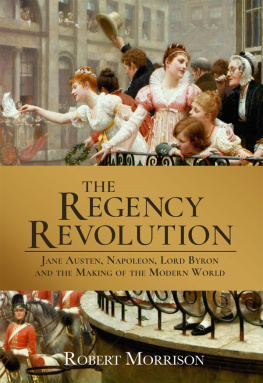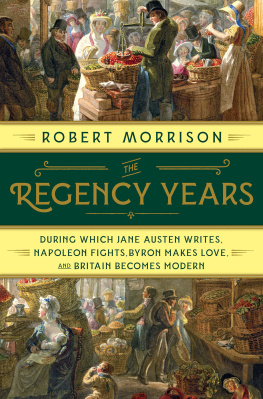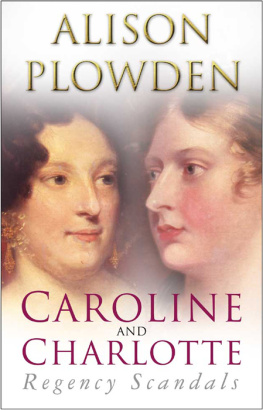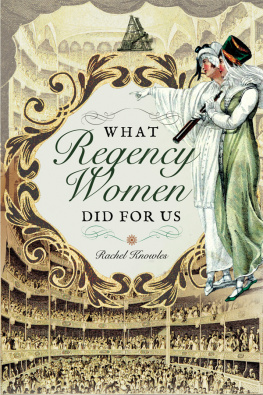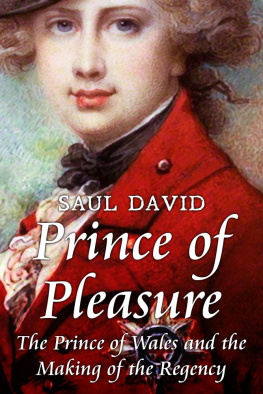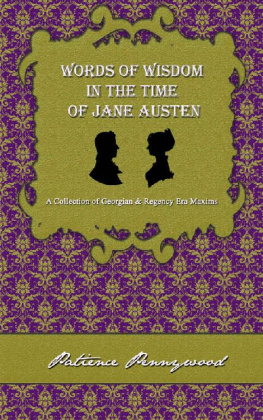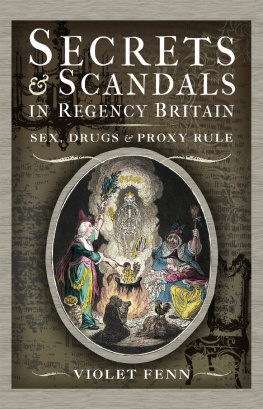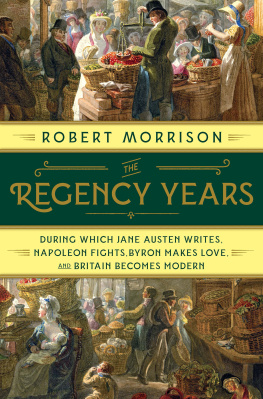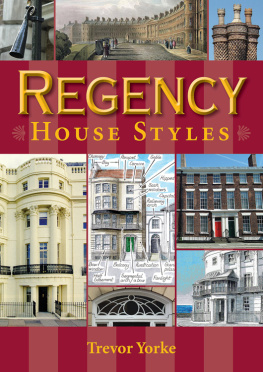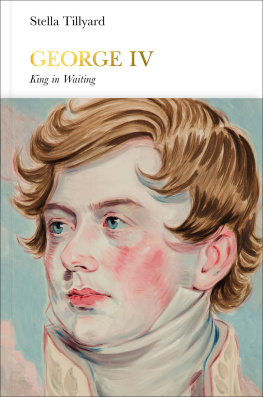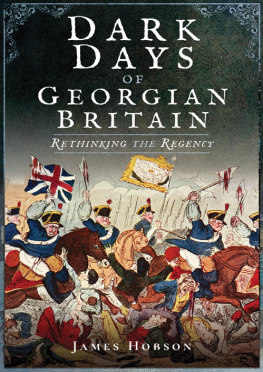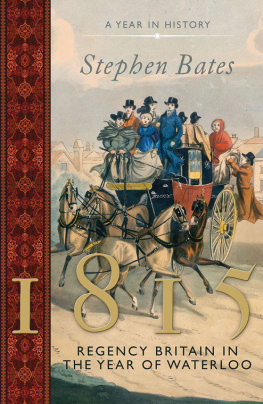Contents
Guide
THE
REGENCY
REVOLUTION
ALSO BY ROBERT MORRISON
The English Opium-Eater: A Biography of Thomas De Quincey
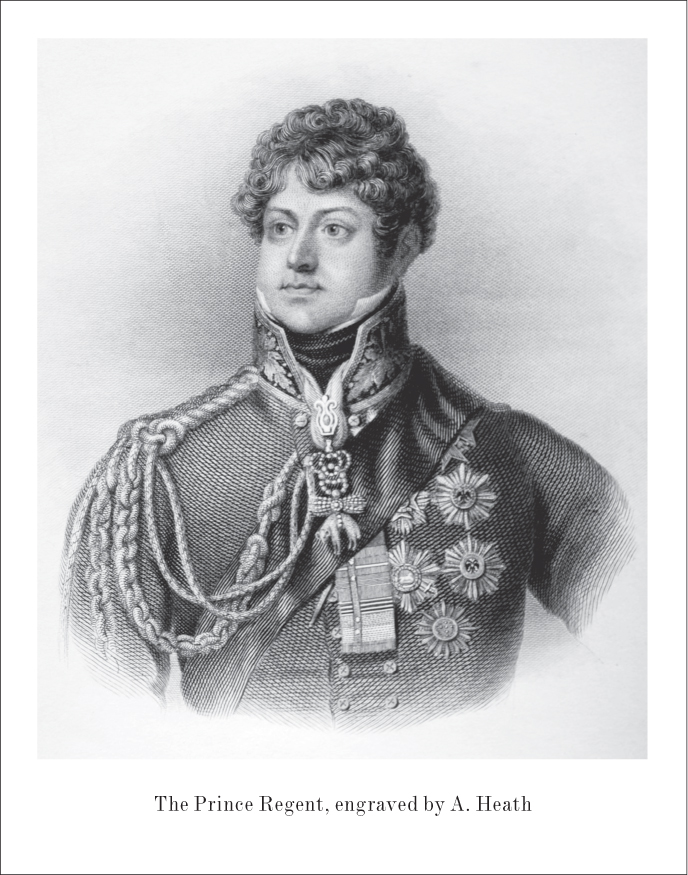
THE
REGENCY
REVOLUTION
Jane Austen, Napoleon, Lord Byron and the Making of the Modern World
ROBERT MORRISON
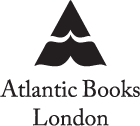
This edition published by arrangement with W.W. Norton & Company, Inc.
First published in Great Britain in 2019 by
Atlantic Books, an imprint of Atlantic Books Ltd.
Copyright Robert Morrison, 2019
The moral right of Robert Morrison to be identified as the author of this work has been asserted by him in accordance with the Copyright, Designs and Patents Act of 1988.
All rights reserved. No part of this publication may be reproduced, stored in a retrieval system, or transmitted in any form or by any means, electronic, mechanical, photocopying, recording, or otherwise, without the prior permission of both the copyright owner and the above publisher of this book.
1 3 5 7 9 8 6 4 2
A CIP catalogue record for this book is available from the British Library.
Hardback ISBN: 978-1-78649-123-7
E-book ISBN: 978-1-78649-124-4
Paperback ISBN: 978-1-78649-125-1
Printed in Great Britain
Atlantic Books
An Imprint of Atlantic Books Ltd
Ormond House
2627 Boswell Street
London
WC1N 3JZ
www.atlantic-books.co.uk
For Carole
Again and Always
CONTENTS

PROLOGUE
The Regent and the Regency
CHAPTER ONE
Crime, Punishment, and the Pursuit of Freedom
CHAPTER TWO
Theaters of Entertainment
CHAPTER THREE
Sexual Pastimes, Pleasures, and Perversities
CHAPTER FOUR
Expanding Empire and Waging War
CHAPTER FIVE
Changing Landscapes and Ominous Signs
EPILOGUE
The Modern World
ACKNOWLEDGMENTS

My research for this book was generously funded by the Social Sciences and Humanities Research Council of Canada. I am deeply grateful for the councils support. I would like to thank the following librarians and archivists for providing extra information and guiding me to new sources: Rachel Foss at the British Library; Susan Halpert at the Houghton Library, Harvard University; Rachel Beattie at the National Library of Scotland; Kimberley Bell, Bonnie Brooks, and Jillian Sparks at the Queens University Library; and Chris Sutherns at Tate Images. For his indispensable assistance on this project, I would especially like to record my thanks to Jeff Cowton of the Wordsworth Trust.
Writing this book has been a complicated and exhilarating task, and I have benefited enormously from the expertise and support of a number of scholars and friends. I am grateful to Chris Baldick, Peter Bell, John Berry, Benjamin Colbert, Roy Golsteyn, Roger Hamilton, Wendy-Lee Hamilton, Kanonhsyonne Janice C. Hill, Markus Iseli, Paul James, Kaveh Khanverdi, Larry Krupp, John Kulka, Grevel Lindop, Amy Loyst, Charles Mahoney, Robert McCullum, Johanna McLeod, Peter McLeod, Martha Paul, Nick Paul, Ian Reed, Bob Richardson, Sir Christopher Ricks, Daniel Sanjiv Roberts, Nicholas Roe, Patricia Meyer Spacks, Lee Spinks, Vinita Srivastava, Nancy Stokes, John Strachan, and Duncan Wu. I would like to thank Lyndon Bray, Randy Paskuski, and Neil Sheets for being my bandmates for all these years. Thank you, as well, to Michael Davie, who has been such a good friend for more than three decades, and who walked with me around the Brighton Pavilion and John Keatss house.
Anthony Holden and Alan Samson both believed in this project right from the start, and I am deeply grateful for their friendship and support. For invaluable assistance and advice, I would like to thank Guy Gavriel Kay and James Nightingale, as well as my literary agents, Julian Alexander and John Silbersack. At W. W. Norton, thank you to Nancy Palmquist and, in particular, to my editor Amy Cherry, who read the manuscript with such care, and who offered so many insightful suggestions.
For their love, friendship, and constant encouragement, I would like to thank Zachary and Alastair.
This book is for Carole.
Leigh House
Brewers Mills
INTRODUCTION

The Regency began on 5 February 1811. King George III had been crowned in 1760, and had presided over both the loss of the American colonies and Britains struggles against Revolutionary and Napoleonic France. But he was replaced as Britains ruler because he suffered from some form of insanity, which struck him down several times during his long reign, and which in late 1810 cast him into darkness, clearing the way for the Regency of his dissolute eldest son, George, Prince of Wales, who ruled Britain as Prince Regent until 29 January 1820, when George III died and the Regent became King George IV. Despite its brevity, the Regency was a time of major events, from the Luddite Riots and the War of 1812 to the Battle of Waterloo, the explosion of Mount Tambora, and the Peterloo Massacre. And it had a glorious cast, including Jane Austen, Beau Brummell, Lord Byron, John Constable, John Keats, Walter Scott, Mary Shelley, Percy Shelley, J. M. W. Turner, the Duke of Wellington, and of course the Regent himself. But there were dozens of other figures who made a decisive contribution to the period, including athletes (Tom Cribb), artists (Mary Linwood and Thomas Rowlandson), engineers (Thomas Telford), explorers (John Franklin), inventors (Charles Babbage), journalists (Pierce Egan), novelists (Mary Brunton and Maria Edgeworth), poets (John Clare), reformers (Elizabeth Fry and Robert Owen), and scientists (Humphry Davy and Michael Faraday). While I recognize the deep continuities between the Regency and the decades that both preceded and followed it, I believe the Regency is perhaps the most extraordinary decade in all of British history. It is certainly the period that most definitively marks the appearance of the modern world.
In fiction, the Regency is brought most vividly to life in William Makepeace Thackerays magnificent Vanity Fair (184748) and in the novels of Georgette Heyer, including Regency Buck (1935) and An Infamous Army (1937). Popular studies began with William Cobbetts History of the Regency and Reign of King George the Fourth (183034), continued through a number of nineteenth- and early-twentiethcentury accounts, and culminated in the 1970s and 1980s in a spate of shorter surveys, including those by Joanna Richardson, Donald Low, and Carolly Erickson. There have been a host of books on individual aspects of the Regency, including its architecture, art, fashion, furniture, politics, prizefighters, and rakes. There have also been a number of studies that fold the Regency into a longer historical survey, including Paul Johnsons magisterial The Birth of the Modern (1991), or that see it variously as a part of the Age of Atonement, the Age of Elegance, the Age of Improvement, the Age of Revolution, or the Age of Wonder. Several studies, too, have been devoted to an examination of the Regency world of individual authors, including, most prominently, Austen and Byron.

